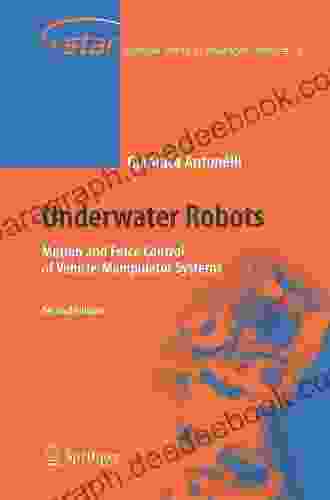Underwater Robots: Springer Tracts in Advanced Robotics 123

Underwater robots are becoming increasingly important for a variety of tasks, from scientific research to military operations. These robots can be used to explore the ocean depths, collect data, and even perform repairs.
5 out of 5
| Language | : | English |
| File size | : | 51602 KB |
| Text-to-Speech | : | Enabled |
| Screen Reader | : | Supported |
| Enhanced typesetting | : | Enabled |
| Print length | : | 647 pages |
Springer Tracts in Advanced Robotics 123 is a new book that provides a comprehensive overview of the latest advancements in underwater robotics. The book is written by leading experts in the field and covers a wide range of topics, including:
- The history of underwater robotics
- The different types of underwater robots
- The design and construction of underwater robots
- The control and navigation of underwater robots
- The applications of underwater robots
Springer Tracts in Advanced Robotics 123 is a valuable resource for anyone interested in learning more about underwater robots. The book is well-written and provides a wealth of information on this rapidly growing field.
The History of Underwater Robots
The history of underwater robots can be traced back to the 19th century. The first underwater robots were simple devices that were used to collect data on the ocean floor. These robots were typically tethered to a surface ship and were limited in their range of motion.
In the 20th century, underwater robots began to become more sophisticated. These robots were able to operate independently of a surface ship and could travel to greater depths. They were also equipped with a variety of sensors and tools that allowed them to perform more complex tasks.
Today, underwater robots are used for a wide range of tasks, including:
- Scientific research
- Military operations
- Oil and gas exploration
- Underwater construction
- Search and rescue operations
The Different Types of Underwater Robots
There are many different types of underwater robots, each with its own unique capabilities. The most common types of underwater robots include:
- Remotely operated vehicles (ROVs)
- Autonomous underwater vehicles (AUVs)
- Hybrid underwater vehicles (HUVs)
ROVs are operated by a human operator using a joystick or other control device. They are typically used for tasks that require a high degree of precision, such as object manipulation and repair. AUVs are self-powered robots that can operate independently of a human operator. They are typically used for tasks that require a long range of motion or that are dangerous for humans to perform. HUVs are hybrid robots that combine the features of both ROVs and AUVs. They are typically used for tasks that require a combination of precision and autonomy.
The Design and Construction of Underwater Robots
The design and construction of underwater robots is a complex process that requires a team of engineers and scientists. The first step in the design process is to determine the purpose of the robot. This will determine the robot's size, shape, and capabilities.
Once the purpose of the robot has been determined, the engineers will begin to design the robot's hull. The hull is the main body of the robot and must be able to withstand the pressure of the water at the depths that the robot will be operating.
The next step is to design the robot's propulsion system. The propulsion system will allow the robot to move through the water. The most common types of propulsion systems for underwater robots are propellers and thrusters.
Once the robot's hull and propulsion system have been designed, the engineers will begin to design the robot's control system. The control system will allow the robot to navigate and perform its tasks. The control system typically consists of a computer, sensors, and actuators.
The final step in the design process is to test the robot. The robot will be tested in a controlled environment to ensure that it meets all of its design specifications.
The Control and Navigation of Underwater Robots
The control and navigation of underwater robots is a challenging task. The water is a dense and unforgiving environment, and robots must be able to operate in a variety of conditions. The most common control and navigation systems for underwater robots are:
- Sonar
- Magnetometers
- Inertial navigation systems (INS)
- Global positioning systems (GPS)
Sonar is a type of sound navigation and ranging system that uses sound waves to determine the distance to objects. Magnetometers measure the Earth's magnetic field to determine the robot's heading. INSs use accelerometers and gyroscopes to determine the robot's position, velocity, and attitude. GPSs use satellites to determine the robot's position.
The control and navigation system for an underwater robot is typically a complex and sophisticated system that requires a team of engineers and scientists to design and operate.
The Applications of Underwater Robots
Underwater robots are used for a wide range of tasks, including:
- Scientific research
- Military operations
- Oil and gas exploration
- Underwater construction
- Search and rescue operations
In scientific research, underwater robots are used to explore the ocean depths and collect data on the ocean environment. They can be used to study marine life, geology, and oceanography.
In military operations, underwater robots are used for a variety of tasks, including mine detection, reconnaissance, and surveillance. They can also be used to deliver weapons and supplies to underwater targets.
In oil and gas exploration, underwater robots are used to search for and recover oil and gas reserves. They can be used to drill wells, lay pipelines, and inspect underwater structures.
In underwater construction, underwater robots are used to perform a variety of tasks, including welding, cutting, and assembly. They can be used to build underwater structures, such as bridges, pipelines, and tunnels.
In search and rescue operations, underwater robots are used to search for and rescue people who have been lost at sea. They can be used to locate survivors, provide medical assistance, and recover bodies.
The Future of Underwater Robots
The future of underwater robots is bright. As technology continues to develop, underwater robots will become more capable and versatile. They will be able to operate in deeper water, for longer periods of time, and in more dangerous conditions.
Underwater robots will play an increasingly important role in a wide range of applications. They will be used to explore the ocean depths, perform scientific research, conduct military operations, and support oil and gas exploration. They will also be used to construct and repair underwater structures, and to search for and rescue people who have been lost at sea.
The future of underwater robots is full of possibilities.
Underwater robots are a rapidly growing field with a wide range of applications. They are used to explore the ocean depths, perform scientific research, conduct military operations, and support oil and gas exploration. As technology continues to develop, underwater robots will become more capable and versatile. They will play an increasingly important role in our lives and in the future of our planet.
5 out of 5
| Language | : | English |
| File size | : | 51602 KB |
| Text-to-Speech | : | Enabled |
| Screen Reader | : | Supported |
| Enhanced typesetting | : | Enabled |
| Print length | : | 647 pages |
Do you want to contribute by writing guest posts on this blog?
Please contact us and send us a resume of previous articles that you have written.
 Book
Book Novel
Novel Chapter
Chapter Text
Text Story
Story Genre
Genre Paperback
Paperback Newspaper
Newspaper Shelf
Shelf Bibliography
Bibliography Preface
Preface Synopsis
Synopsis Footnote
Footnote Scroll
Scroll Codex
Codex Tome
Tome Biography
Biography Memoir
Memoir Encyclopedia
Encyclopedia Dictionary
Dictionary Thesaurus
Thesaurus Character
Character Resolution
Resolution Librarian
Librarian Card Catalog
Card Catalog Stacks
Stacks Archives
Archives Periodicals
Periodicals Research
Research Scholarly
Scholarly Reserve
Reserve Academic
Academic Journals
Journals Rare Books
Rare Books Interlibrary
Interlibrary Literacy
Literacy Storytelling
Storytelling Reading List
Reading List Theory
Theory Textbooks
Textbooks Nancy Streza
Nancy Streza T D Jakes
T D Jakes Tanya Ovenden Hope
Tanya Ovenden Hope Ardi Aaziznia
Ardi Aaziznia Graham Lovell
Graham Lovell David H Pascoe
David H Pascoe Pat Walsh
Pat Walsh Timothy Ball
Timothy Ball Mark Pendergrast
Mark Pendergrast Zoila S Mendoza
Zoila S Mendoza David M Nienow
David M Nienow K L Ramsey
K L Ramsey Paul Hellyer
Paul Hellyer Candice Adewole
Candice Adewole Didi Jackson
Didi Jackson Ioannis Anastassakis
Ioannis Anastassakis Steve Gordon
Steve Gordon Mrgoodgoeshard
Mrgoodgoeshard Daniel Ankele
Daniel Ankele Nkechi Anya
Nkechi Anya
Light bulbAdvertise smarter! Our strategic ad space ensures maximum exposure. Reserve your spot today!

 Anthony WellsUnveiling the Eerie World of The Hollow Ones: A Blackwood Tapes Investigation
Anthony WellsUnveiling the Eerie World of The Hollow Ones: A Blackwood Tapes Investigation Mario Vargas LlosaFollow ·7.4k
Mario Vargas LlosaFollow ·7.4k Wesley ReedFollow ·13.3k
Wesley ReedFollow ·13.3k Ivan TurgenevFollow ·14.7k
Ivan TurgenevFollow ·14.7k F. Scott FitzgeraldFollow ·9.8k
F. Scott FitzgeraldFollow ·9.8k Dean ButlerFollow ·7.5k
Dean ButlerFollow ·7.5k Vincent MitchellFollow ·3.4k
Vincent MitchellFollow ·3.4k Richard SimmonsFollow ·14.9k
Richard SimmonsFollow ·14.9k Craig BlairFollow ·4.5k
Craig BlairFollow ·4.5k

 Ricky Bell
Ricky BellThe Marriage: An Absolutely Jaw-Dropping Psychological...
In the realm of...

 Ray Blair
Ray BlairDiscover the Enchanting Charm of Budapest and Its...
Nestled in the heart of...

 Tyrone Powell
Tyrone PowellHuddle: How Women Unlock Their Collective Power
Huddle is a global movement that empowers...

 Grayson Bell
Grayson BellThe Coin Story of the Holocaust: A Symbol of Hope and...
In the depths of the...

 Virginia Woolf
Virginia WoolfFolklore Performance and Identity in Cuzco, Peru: A...
Nestled amidst...

 Dylan Mitchell
Dylan MitchellThe Enduring Love Story of Héloïse and Abélard: A Tale of...
An Intellectual Passion In the heart of...
5 out of 5
| Language | : | English |
| File size | : | 51602 KB |
| Text-to-Speech | : | Enabled |
| Screen Reader | : | Supported |
| Enhanced typesetting | : | Enabled |
| Print length | : | 647 pages |










